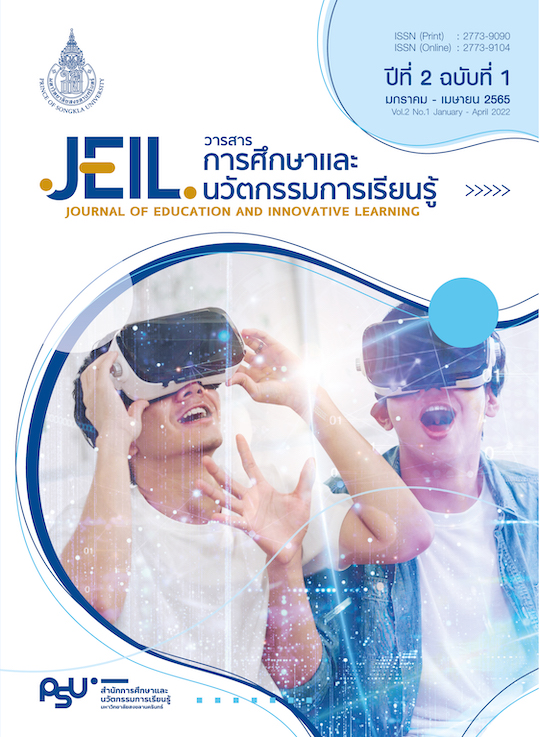ความไม่สอดคล้องด้านการรู้คิดของอาจารย์กับการเรียนการสอนที่มุ่งผลลัพธ์
Main Article Content
บทคัดย่อ
การศึกษานี้ใช้กรอบทฤษฎีความไม่สอดคล้องด้านการรู้คิด เพื่อทำความเข้าใจประสบการณ์ของอาจารย์มหาวิทยาลัยที่ปรับการเรียนการสอนตามแนวทางของการศึกษาที่มุ่งผลลัพธ์ การศึกษานี้เป็นการวิจัยเชิงคุณภาพ เก็บข้อมูลด้วยวิธีการสัมภาษณ์เชิงลึก และวิเคราะห์ข้อมูลด้วยการวิเคราะห์เนื้อหาและจัดกลุ่มเนื้อหา กลุ่มตัวอย่าง คือ อาจารย์จำนวน 9 คน ที่ใช้หลักการ Constructive Alignment ในการออกแบบการเรียนการสอนในระดับรายวิชา ผลการวิเคราะห์เนื้อหาพบว่าอาจารย์มีความไม่สอดคล้องด้านการรู้คิดใน 3 ด้าน คือ ทัศนคติของผู้เรียนต่อการเรียนเพื่อสอบ ปัญหาทางเทคนิคและการปฏิบัติเมื่อใช้เกณฑ์การให้คะแนนหรือรูบริคในการประเมินการเรียนรู้ และการปฏิบัติตามระบบการตัดเกรด ผลการวิจัยชี้ว่าความเชื่อของอาจารย์ต่อ OBE ในแนวทางของ Transformational Approach ส่งผลต่อการเกิดภาวะความไม่สอดคล้องกันดังกล่าว และแม้อาจารย์มีแรงจูงใจของตนที่ทำให้พยายามและมุ่งมั่นในการเปลี่ยนแปลง อาจารย์มีความคาดหวังในระดับสูงกว่าการเรียนการสอนแบบ OBE จะเกิดขึ้นในระดับปฏิบัติได้ด้วยการสนับสนุนจากนโยบายในระดับสถาบัน จากภาวะความไม่สอดคล้องใน 3 ด้านที่พบในอาจารย์กลุ่มตัวอย่าง สถาบันมีบทบาทอย่างมากในการสร้างภาวะความสอดคล้องให้เกิดขึ้น โดยขับเคลื่อนหลักการสำคัญของ OBE ที่ระดับหลักสูตรและสภาพแวดล้อมที่เกี่ยวข้องจากระดับนโยบาย
Article Details

อนุญาตภายใต้เงื่อนไข Creative Commons Attribution-NonCommercial-NoDerivatives 4.0 International License.
เนื้อหาและข้อมูลในบทความที่ตีพิมพ์ในวารสารการศึกษาและนวัตกรรมการเรียนรู้ ถือเป็นข้อคิดเห็นและความรับผิดชอบของผู้เขียน ซึ่งกองบรรณาธิการวารสาร ไม่จำเป็นต้องเห็นด้วยหรือร่วมรับผิดชอบใด ๆ และไม่สงวนสิทธิ์การคัดลอกบทความเพื่อใช้ประโยชน์ทางวิชาการ แต่ให้อ้างอิงข้อมูลแสดงที่มาของบทความทุกครั้งที่นำไปใช้ประโยชน์
เอกสารอ้างอิง
Aronson, E. (1968). Dissonance theory: progress and problems. In R. P. Abelson, E. Aronson, W. J. McGuire, T. M. Newcomb, M. J. Rosenberg, & P. H. Tannenbaum (Eds.), Theory of cognitive consistency: A sourcebook. (5-27). Chicago: Rand McNally.
Biggs, J. B., & Tang, C. (2011). Teaching for quality learning at university (4th ed.). Buckingham: Open University Press.
Bohlmann, N., & Weinstein, R. S. (2013). Classroom context, Teacher expectations and Cognitive Level: Predicting childrenís maths ability judgements. Journal of Applied Developmental Psychology, 34, 288-298.
Brady, L. (1994). Outcome based education: resurrecting the objectives debate. New Education, 16(2), 69-75.
Braaten, M., Granados, E., & Bradford, C. (2022). Making sense through dissonance during preservice teacher preparation. Teaching and Teacher Education, 109, 103541. doi: 10.1016/j.tate.2021.103541
Cooper, J., & Fazio, R. H. (1984). A new look at dissonance theory. Advances in Experimental Social Psychology, 17, 229-266. doi:10.1016/S0065-2601(08)60121-5
Cumming, A., & Ross, M. (2007). The tuning project for medicine-learning outcomes for undergraduate medical education in Europe. Medical Teacher, 29(7), 636-641. doi:10.1080/01421590701721721.
Delaney, K. K. (2015). Dissonance for understanding: Exploring a new theoretical lens for understanding teacher identity formation in borderlands of practice. Contemporary Issues in Early Childhood, 16(4), 374-389. doi:10.1177/1463949115616326
Donnelly, K. (2007). Australia's adoption of outcomes based education: a critique. Issues in educational research, 17(2), 183-206.
Entwistle, N. (2009). Teaching for understanding at university: Deep approaches and distinctive ways of thinking. Basingstoke, Hampshire: Palgrave Macmillan
Eren, A. (2010). Consonance and dissonance between Turkish prospective teachersí values and practices: Conceptions about teaching, learning, and assessment. Australian Journal of Teacher Education, 35(3), 27-48.
Festinger, L. (1957). A theory of cognitive dissonance. Stanford, CA: Stanford University Press.
Frank, J. R., & Danoff, D. (2007). The CanMEDS initiative: implementing an outcomes-based framework of physician competencies. Medical Teacher, 29(7), 642-647. doi:10.1080/01421590701746983.
Gutierez, S. B. (2020). Collaborative lesson planning as a positive ëdissonanceíto the teachersí individual planning practices: characterizing the features through reflections-on-action. Teacher Development, 25(1), 37-52. doi:10.1080/13664530.2020.1856177
Harden, R. M. (2002). Developments in outcome-based education. Medical Teacher, 24(2), 117-120.
Harmon-Jones, E., Amodio, D. M., & Harmon-Jones, C. (2009). Action-based model of dissonance: A review, integration, and expansion of conceptions of cognitive conflict. In M. P. Zanna (Ed.), Advances in experimental social psychology. (119-166). Elsevier Academic Press.
Harmon-Jones, E., Harmon-Jones, C., & Levy, N. (2015). An action-based model of cognitive-dissonance processes. Current Directions in Psychological Science, 24(3), 184-189.
Henderson, C., & Dancy, M.H. (2007). Barriers to the use of research-based instructional strategies: The influence of both individual and situational characteristics. Physical Review Special Topics-Physics Education Research, 3(2), 020102. doi:10.1103/PhysRevSTPER.3.020102
Hinojosa, A. S., Gardner, W. L., Walker, H. J., Cogliser, C., & Gullifor, D. (2017). A review of cognitive
dissonance theory in management research: Opportunities for further development. Journal of Management, 43(1), 170-199.
Ince, A. (2016). Managing risk in complex adult professional learning: the facilitatorís role. Professional Development in Education, 43(2), 194-211. doi:10.1080/19415257.2016.1164743
James, M., & McCormick, R. (2009). Teachers learning how to learn. Teaching and Teacher Education, 25(7), 973-982.
Klongvessa, N. (2011). Outcome-based curriculum and alteration in landscape architecture lesson plan. Paper presented at IFLA APR Symposium on Landscape Architecture Education, Putra, Malaysia. Retrieved from http://www.land.arch.chula.ac.th/data/file_20110404172156.pdf
Malterud, K., Siersma, V. D., & Guassora, A. D. (2015). Sample size in qualitative interview studies: guided by information power. Qualitative Health Research, 26(13), 1753-1760. doi:10.1177/1049732315617444
Mason, J. (2002). Qualitative researching (2nd ed.). London: Sage.
Meyer, J. H. F. (2000). The modelling of ëdissonantí study orchestration in higher education. European Journal of Psychology of Education, 25(1), 5-18. doi:10.1007/BF03173163
Morcke, A. M., Dornan, T., & Eika, B. (2013). Outcome (competency) based education: an exploration of its origins, theoretical basis, and empirical evidence. Advances in Health Sciences Education, 18(4), 851-863.
Oliver, R. L. (1997). Satisfaction: A behavioral perspective on the consumer. New York: McGraw-Hill.
Pinit, P., Anmanatrakul, A., & Meearsa, J. (2020). Outcomes-based grading in an outcomes-based education. Walailak Journal of Learning Innovations, 6(2), 59-96.
Postareff, L., Katajavuori, N., Lindblom-Yl‰nne, S., & Trigwell, K. (2008). Consonance and dissonance in descriptions of teaching of university teachers. Studies in Higher Education, 33(1), 49-61. doi:10.1080/03075070701794809
Prosser, M., Ramsden, P., Trigwell, K., & Martin, E. (2003). Dissonance in experience of teaching and its relation to the quality of student learning. Studies in Higher Education, 28(1), 37-48. doi:10.1080/03075070309299
Ros·rio, P., N˙Òez, J. C., Ferrando, P. J., Paiva, M. O., LourenÁo, A., Cerezo, R., & Valle, A. (2013). The relationship between approaches to teaching and approaches to studying: A two-level structural equation model for biology achievement in high school. Metacognition and learning, 8(1), 47-77. doi:10.1007/s11409-013-9095-6
Spady, W. G., & Marshall, K. (1991). Beyond traditional outcome-based education. Educational Leadership, 49(2), 67-72.
Spady, W. G. (1994). Outcome-based education: Critical issues and answers. Arlington, VA: American Association of School Administrators.
Swain, M. S., Gliedt, J. A., de Luca, K., Newell, D., & Holmes, M. (2021). Chiropractic studentsí cognitive dissonance to statements about professional identity, role, setting and future: international perspectives from a secondary analysis of pooled data. Chiropractic & Manual Therapies, 29(1), 1-10. doi:10.1186/s12998-021-00365-6
Tamronglak, A. (2020) Impacts of the Thailand qualification framework-public administration on public administration education in Thailand. Journal of Public Affairs Education, 26(3), 276-290. doi:10.1080/15236803.2020.1771991
Treacy, M., & Leavy, A. (2021). Student voice and its role in creating cognitive dissonance: The neglected narrative in teacher professional development. Professional Development in Education, 1-20. doi:10.1080/19415257.2021.1876147
Wiggins, G., & McTighe, J. (2005). Understanding by Design (2nd ed.). Alexandria, VA: Association for Supervision and Curriculum Development.


